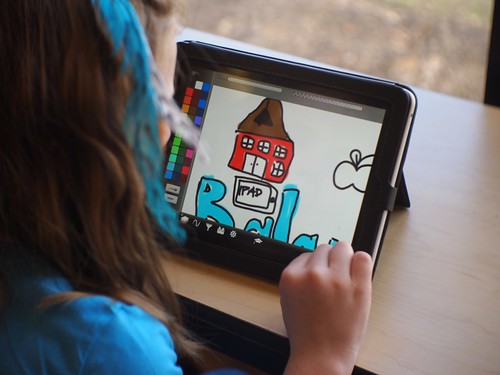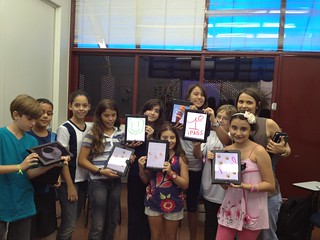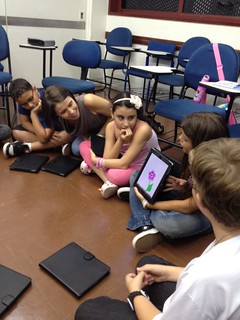- translation encourages a dependence on the L1,
at the expense of the learner constructing an independent L2 system;
- translation encourages the notion of equivalence
between languages, yet no two languages are exactly alike (although languages
from the same language family may be similar in lots of respects);
- the L1 system interferes with the development of
the L2 system;
- translation is the “easy” approach to conveying
meaning, and is therefore less memorable than approaches that require more
mental effort, such as working out meaning from context;
- the “natural” way of acquiring a language is
through direct experience and exposure, not through translation.
I confess to having taught numerous groups of true beginners
without ever, ever speaking a word in Portuguese, our common native language,
in class. After all, what if they were in the U.S or the U.K, right? No one
would speak their language there, so we had to simulate this L2 environment. At
that time, I truly and naively believed that native speakers were the model for
an L2 classroom and that students’ L1 was mostly an interference to be avoided.
I’m sure this belief was also reinforced by the fact that English in regular
schools in Brazil, public or private, was based solely on translation and was
very ineffective, so doing anything similar to that should be avoided at all
costs.
It was only in the mid-90’s, when I first read what would be
one of my most cherished methodology bibles, Douglas Brown’s (2007) Teaching By Principles, that I came
across the idea that “the judicious use of the L1” can be beneficial. Wow! That
was already quite a stretch for me. But still, in the Methodology classes I
taught, I always emphasized the word judiciously, and explained that it was
really an exception, when there was no other way to explain a word or concept.

As time went by and a growing number of experts began
defending the idea that the native language can be a facilitative tool, rather
than just a hindrance or an interference (Atkinson, 1987; Auerbach, 1993; Cook,
2001; Nation, 2003), I slowly began to rethink my beliefs about this issue and,
as a teacher, adopt a greater tolerance towards the idea that we can use this
tool learners already have, their native language, to help them learn a second
language. Rather than a hindrance, the L1 can sometimes be a springboard, or
maybe the key to understanding. When teaching the present perfect, for example,
I started to show my students that in Portuguese you say “I have read that
book” and “I read that book yesterday” using the same verb (li), the reason why it was difficult for
Brazilians to understand the concept of the present perfect. I would thus warn
them that relating it to Portuguese wasn’t going to help. Conversely, when
Portuguese could indeed help them understand something, I began signaling this
to students, saying, “It’s just like in Portuguese.” With children, the idea of
giving them a few minutes in the beginning of the class to share whatever they
felt like sharing about their lives in the native language became more
acceptable. After all, they weren’t proficient enough to express themselves the
same way in English, yet they really needed the emotional bond.
Even so, my understanding of the debate about the role of L1
in the L2 classroom was still very pragmatic and “apolitical”. It was only when
I became more familiarized with Critical Applied Linguistics (Pennycook, 2001),
the Local Versus Global English debate and World Englishes, and the
Non-native-English-Speaking-Teacher movement (Braine, 1999) that my view of the
topic expanded. I began to understand all the historical, theoretical, and
political reasons behind the “English-only” policy, clearly explained by
Mahboob
(2011) and summarized in an earlier
post.
The fact that sharing the same L1 with my students was a strength rather than a
weakness really empowered me and made me rethink my role as a teacher and
teacher trainer and developer. I also enhanced my understanding that there was
a difference between using translation as a method and using the L1 system as a
reference for students, a facilitator.
Though I had “seen the light”, I also
still had many doubts:
- How far should the teacher go in resorting to
the L1 when it can be facilitative without transforming the communicative
classroom into a translation-based one?
- Might the teacher’s reference to students’ L1
make them feel more comfortable to use their L1 in class and not make as much
effort to communicate in the L2, wasting the only time they have to do so (in
the case of an EFL environment)?
- Might an excessive comparison or reference to
the L1 hinder the development of students’ automaticity in the foreign
language, creating an unnecessary “L1 bypass” in their brains?
Paul Seligson’s plenary in an event recently held at my ELT
Institute – the
2nd Alumni, CTJ, and Ibeu TEFL
Conference – shed some light
into this discussion and helped clarify it for me in certain ways. He
reasonably argued that “L1 is a tool to be used appropriately like any other,
and its use needn’t be verbal.” It can
involve parallel processing or systematic contrastive reflection, for example.
He suggested a number of awareness-raising activities that involve students
making comparisons between their L1 and EFL without having to say a word in
their L1. For example, students can think about whether the stressed syllable
in each of the months in English is the same or different from in Portuguese.
This can be done between Portuguese and English because the months in the two
languages are of Latin origin. Thus, we can capitalize on the fact that
Portuguese is a Romance language, that as much as 60% of English is
Latin-based, and that there are more cognates than false cognates between Portuguese
and English. Students can be trained to notice cognates and near cognates and
work out their meaning from context. This can be done without even using the L1
in the classroom, but rather, just asking students to think about it. Seligson
(2013) also argues that if we capitalize on the vocabulary that is Latin-based
when teaching beginners, we can speed up their learning and give them a sense
of being able to communicate adequately sooner, even if the words they’re using
aren’t necessarily the most frequently used by native speakers.
Some of the key ideas put forth by Seligson (2013) are:
- Highlight, use, and build on students’ strong,
existing linguistic intelligence, addressing them as “insiders”, knowers, not
“empty vessels” or aliens from another language planet.
- Consider making reference to L1 whenever it
might help; celebrate and accelerate where things are similar, prioritize
what’s harder, and make humorous links.
- L1 is a tool to be used appropriately like any
other, and its use needn’t be verbal, e.g. parallel processing, systematic
contrastive reflection, etc.
- Accelerate presentations using L1 contrast or
references to give them more time for practice.
- Anticipate mistakes early on in lessons to help
students avoid them.
- Use cognates to provide much richer text and
input, and be explicit when you’re using cognates.
- Make systematic use of contrastive pronunciation
to help break the habits they have acquired from L1.
- Our goal is to create successful language
switchers, not just turn them into native speakers.
I opened this post with Thornbury’s (2010) list of arguments
against the use of L1. Now here is his list of arguments in favor, which
certainly inspired Seligson in his plenary:
- New knowledge (e.g. of the L2) is constructed on
the basis of existing knowledge (e.g. of the L1), and to ignore that is to deny
learners a valuable resource.
- Languages have more similarities than
differences, and translation encourages the positive transfer of the
similarities, as well as alerting learners to significant differences.
- Translation is a time-efficient means of
conveying meaning, compared, say, to demonstration, explanation, or working out
meaning from context.
- Learners will use translation, even if covertly,
as a strategy for making sense of the L2, so it may as well be used as an overt
tool.
- The skill of translation is an integral part of
being a proficient L2 user, and contributes to overall pluralingualism.
- Translation is a natural way of exploiting the
inherent bilingualism of language classes, especially where the teacher is
herself bilingual.
Just the other day I was teaching a group of
low-intermediate adults and we came across the word “confident”, a
false-cognate in Portuguese. Unhesitatingly, I pointed out that confident meant
confiante, not confidente in Portuguese. Twenty years ago, I would probably not
have resorted to translation and tried to explain the word in English. Maybe
half of my students would have understood it, while half would still either be
in doubt or think that it meant confidente.
As you can see, I’m now a believer and, as a teacher, I
think I can make informed decisions about when to use or allow the use of L1 in
my classroom. However, as a teacher trainer and developer in an ELT Institute
with over 250 teachers, many of whom are novice, I confess I’m still reluctant
to openly advocate the use of L1. My
fear is that the arguments above become an overgeneralization for any use of
the L1 at any time, both by the teacher and the students. This would go against
our institutional pedagogical principles, which emphasize the need to maximize
L2 use in the classroom and authentic communication in L2 and, above all, our
students’ expectations. Thus, apart from L1 use for classroom management
purposes and others presented by Mahboob (2011), Seligson’s idea of having
students think about their L1 rather than actually use it in class might be a
sound suggestion.
And you? How do you feel about this issue as a teacher? And
as a teacher trainer/developer?
References
Auerbach, E.
(1993). Reexaming English only in the ESL classroom. TESOL Quarterly, 27, 1, pp.
9–32.
Atkinson, D.
(1987). The mother tongue in the classroom: A neglected resource? ETL Journal, 41,
4, pp.
241–24.
Braine, G.
(Ed.). (1999). Nonnative Educators in
English Language Teaching. Mahwah, NJ: Lawrence Erlbaum.
Brown, H. D.
(2007). Teaching by Principles – An
Interactive Approach to Language Pedagogy – 3rd Edition. White
Plains, NY: Pearson Education.
Cook, V.
(2001). Using the First Language in the Classroom. Canadian Modern Language Review, 57(3).
Pennycook,
A. (2001). Critical Applied Linguistics
– A Critical Introduction. Mahway, NJ: Lawrence Erlbaum.
Seligson, P.
(2013). Advantaging Brazilian Learners.
Plenary delivered at the 2nd Alumni, CTJ, and Ibeu TEFL Conference.
 WordFoto is an easy and fun app for the language classroom. Students take pictures and write words and sentences that will appear all over the image. The app is light and students do not need more than 5 minutes to get the work done. The app only accepts up to 10 words.
WordFoto is an easy and fun app for the language classroom. Students take pictures and write words and sentences that will appear all over the image. The app is light and students do not need more than 5 minutes to get the work done. The app only accepts up to 10 words. We can use the camera native app for a number of activities, but I like the simplicity of memory games. I was teaching "going to", and there was a picture in the book that students had to describe all the about to actions people in the picture were doing. I asked students to pose for a picture to have a similar task and motivate them to practice the target structure and have fun. They love working with their own pictures! Screen Chomp is basically a doodling app with markers.
We can use the camera native app for a number of activities, but I like the simplicity of memory games. I was teaching "going to", and there was a picture in the book that students had to describe all the about to actions people in the picture were doing. I asked students to pose for a picture to have a similar task and motivate them to practice the target structure and have fun. They love working with their own pictures! Screen Chomp is basically a doodling app with markers. I was teaching adverbs of frequency and frequency words to talk about routine. To transition from sentence level to discourse level, I used an activity suggested on Cleide Nascimento`s blog - Draw My Attention to contextualize the topic, and asked students to reorder the activities according to their daily routines and narrate the slides. I `ll use their work as resource for follow up activities.
I was teaching adverbs of frequency and frequency words to talk about routine. To transition from sentence level to discourse level, I used an activity suggested on Cleide Nascimento`s blog - Draw My Attention to contextualize the topic, and asked students to reorder the activities according to their daily routines and narrate the slides. I `ll use their work as resource for follow up activities. With Screen Chomp students can record audios or videos or upload a file, and then use the drawings tools to jolt down ideas, label, point out, etc. I have used it as a way to brainstorm ideas as a pre-writing activity.
With Screen Chomp students can record audios or videos or upload a file, and then use the drawings tools to jolt down ideas, label, point out, etc. I have used it as a way to brainstorm ideas as a pre-writing activity. Educreations is a useful tool that can be used in many different ways. I used it to practice vocabulary items in a simple way. I asked students to draw clothing items with the app and then used their work to practice the words.
Educreations is a useful tool that can be used in many different ways. I used it to practice vocabulary items in a simple way. I asked students to draw clothing items with the app and then used their work to practice the words.



























